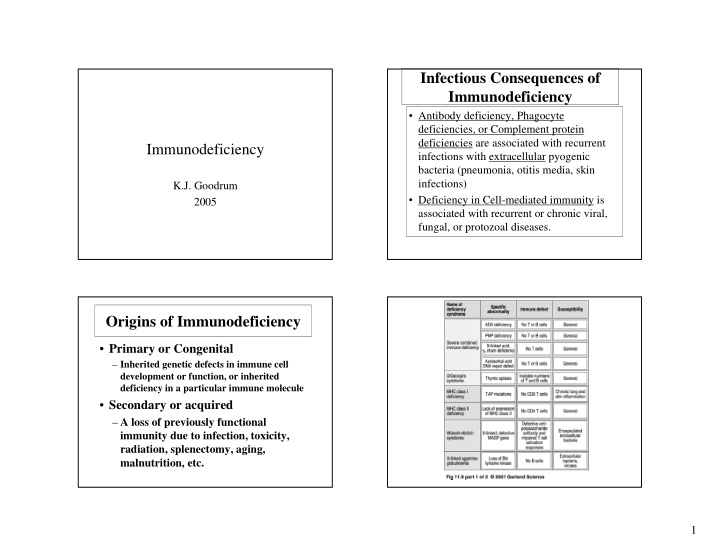



Infectious Consequences of Immunodeficiency • Antibody deficiency, Phagocyte deficiencies, or Complement protein deficiencies are associated with recurrent Immunodeficiency infections with extracellular pyogenic bacteria (pneumonia, otitis media, skin infections) K.J. Goodrum • Deficiency in Cell-mediated immunity is 2005 associated with recurrent or chronic viral, fungal, or protozoal diseases. Origins of Immunodeficiency • Primary or Congenital – Inherited genetic defects in immune cell development or function, or inherited deficiency in a particular immune molecule • Secondary or acquired – A loss of previously functional immunity due to infection, toxicity, radiation, splenectomy, aging, malnutrition, etc. 1
B cell Deficiencies T Cell Deficiencies • Congenital hypogammaglobulinemia • Congenital Thymic aplasia – Symptoms at 9 mo. to 2 yr of age • Chronic Mucocutaneous Candidiasis – Treat with intravenous immunoglobulin (IVIG) • Hyper IgM : defective CD-40L expression • Selective IgA deficiency – Occurs in 1:600-1:800 people – Possible connection with increased sinopulmonary infections and allergies 2
Severe Combined Immunodeficiency Complement Deficiencies • X-linked SCID : • Single component deficiencies – Defect in IL-2 receptor – Example: C3 deficiency • Swiss-Type SCID • Hereditary Angioedema – C1 Inhibitor deficiency – Adenosine deaminase deficiency • Bare Lymphocyte syndrome • C5,C6,C7,C8, or C9 deficiency – Absence of MHC Class II gene products – Recurrent bacterial meningitis due defective membrane attack complex Causes of Acquired Phagocyte Deficiencies Immunodeficiency • Cancer (immunoproliferative diseases) • Chronic Granulomatous Disease • Cytotoxic drugs or radiation – NADPH oxidase defect • Malnutrition • Chediak -Higashi Syndrome • Splenectomy – Abnormal lysosome formation • Immunosuppressive therapies • Leukocyte Adhesion Deficiency • Stress/emotions – Absence of leukocyte adhesion molecules • Aging (thymic atrophy) • Infection 3
Immunopathogenesis of HIV- Immunopathogenesis of HIV- Infection Infection. (continued) • HIV infects and ultimately destroys CD4+ , • Overt AIDS: CD4 count declines, viral CCR5+ or CXCR4+ T cells, monocytes, & load increases, opportunistic dendritic cells. infections. • Primary HIV Infection : A vigorous immune response to HIV controls the primary infection. ( clonal Cytotoxic T cells, suppressive chemokines, poorly neutralizing antibody) Immunopathogenesis of HIV- Infection. (continued) • Chronic Asymptomatic Phase: Viral trapping & replication in lymphoid tissues, high rate turnover of virus and CD4 T cells, loss of CD4 functional help to CTL and antibody responses, destruction of lymph tissue ,, viral mutation and escape from recognition, exhaustion or viral inhibition of CD4 T cell renewal . 4
Mechanisms of CD4+ T cell depletion- Dysfunction • Accumulation of unintegrated viral DNA • Loss of plasma membrane integrity due to viral budding • Elimination of infected cells by HIV- specific immune effectors • Syncytium formation • Autoimmunity Mechanisms of CD4+ T cell depletion- Dysfunction(continued) • Superantigenic stimulation • Apoptosis • Infection of stem cells and interference with lymphopoiesis B Menu F 5
Recommend
More recommend